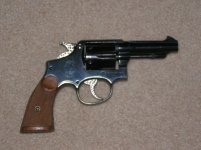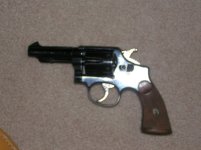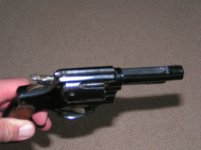bullseye shooter said:
...there is no v in front of or behind an of the numbers. as for the caliber it is a 38 S&W not a special.
The .38 S&W chambering, the gun's features, and the revolver's backstory strongly suggest that this is a WWII (not WWI) .38/200 British Service Revolver. The serial number is still a question mark.
James K said:
...that serial number (with no V) is too early for either U.S. or Allied military issue. I suspect there is a "V" in that serial number.
James is absolutely correct.
I've had a chance to check my literature, and the British serial numbers supposedly start around 680,000, rather than 800,000 as I posted earlier.
However, my (and James') general point is still the same: both 668XXX
and 26XXX are outside of the WWII serial number range
unless there is a "V" prefix. According to the
Standard Catalog of Smith & Wesson, 3rd edition, by Supica & Nahas, the WWII military K frame serial number ranges are c. 680,000-999,999 (no prefix), V1-V769,000, and SV769,001-SV811,832. A large number of commercial guns are intermingled in the initial no-prefix serial range, as S&W sold many guns to the Brits prior to Pearl Harbor and the suspension of commercial production. The initial British .38/200's are cosmetically similar to commercial models, except chambered in .38 S&W. Later guns had a number of changes to reduce cost and expedite production.
668XXX (no prefix)
could be the serial number of a
prewar commercial .38 Military & Police Model of 1905, 4th Change. If one overlooks the modified barrel, some of this gun's features are consistent with a mid-1930's commercial Model of 1905,
except that this model would be chambered in .38 Special and
not .38 S&W.
OTOH the gun's features are wrong for a S&W K frame with a serial number of 26XXX (no prefix), which would be an early .38 M&P Model of 1902.
bullseye shooter said:
There is no lanyard loop nor plug where a loop may have been.
IMHO the gun has been refinished. This is evident in the rounded or "dished" edges of the sideplate. On refinished WWII Victories and .38/200's, some gunsmiths did a better job of disguising the plug than others.
The primary hallmark of a plugged lanyard loop hole is that the serial number will still be off-center, usually to the rear, to clear the now-disguised hole; as I posted earlier, the "V" or "SV" prefix was
sometimes stamped on the opposite side of the hole from the number. OTOH commercial S&W's without lanyard loops have the serial number more-or-less centered on the butt.
Other tidbits...
The barrel is a rather creative custom gunsmithing job.

I'm almost certain that no standard-production S&W has ever been made with a barrel like that.
The jeweled or turned finish on the hammer and trigger is not original either.
The stocks (grips) appear to be reproductions of very early 20th-century (c. 1910) wood K frame stocks. The genuine article would have diamond-shaped escutcheons around the screw holes. Very early WWII military guns have similar checkered wood stocks, but with small circular silver S&W-trademark medallions at the tops; later WWII guns, and the bulk of WWII production, have smooth and featureless wood stocks with no medallions or checkering (as in Saxon's picture).




